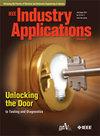Design and Implementation of Underwater Inductive Power Transfer Systems With An Accurate Eddy Current Loss Model Approach
IF 4.2
2区 工程技术
Q2 ENGINEERING, ELECTRICAL & ELECTRONIC
引用次数: 0
Abstract
This study analyzes an underwater inductive wireless power transfer (UIWPT) to be used in offshore vehicles. Fixating on inadvertent eddy current losses (ECLs), this study offers an approach to tackle this concern based on the optimal selection of main design parameters of Archimedean magnetic coils. An accurate analytical electromagnetic field model is derived for directly calculating ECLs, and based on the ECL model, the main design parameters of coils are selected. The electrical fundamental components of coils are calculated as a function of the selected design parameters. A numerical metaheuristic optimization method along with the formulation of a multi-objective function and inequality constraints is utilized to estimate the selected parameters of coils. This function addresses various design objectives simultaneously, considering the water medium and inequality constraints. For optimization purposes, an electrical equivalent circuit model is derived, considering the ECLs impact by reflecting these losses in the equivalent circuit model. The ECL model is verified through Finite Element Analysis (FEA). Finally, a laboratory scale setup is developed and UIWPT experiments are conducted to validate the equivalent circuit and analytical modeling, the calculation of components, and the simulation study.基于精确涡流损耗模型的水下感应电力传输系统设计与实现
本研究分析了一种用于海上航行器的水下感应无线电力传输(uwpt)。本研究针对非故意涡流损耗(ecl)问题,提出了一种基于阿基米德磁线圈主要设计参数优化选择的解决方法。推导了一种精确的解析电磁场模型,用于直接计算电阻抗,并在此基础上选择了线圈的主要设计参数。计算线圈的电气基本元件作为所选设计参数的函数。采用数值元启发式优化方法,结合多目标函数和不等式约束对线圈所选参数进行估计。考虑到水介质和不等式约束,该函数同时解决了各种设计目标。为了优化目的,推导了一个等效电路模型,通过在等效电路模型中反映这些损耗来考虑ecl的影响。通过有限元分析对ECL模型进行了验证。最后,建立了一个实验室规模的装置,并进行了uwpt实验,以验证等效电路和分析建模、元件计算和仿真研究。
本文章由计算机程序翻译,如有差异,请以英文原文为准。
求助全文
约1分钟内获得全文
求助全文
来源期刊

IEEE Transactions on Industry Applications
工程技术-工程:电子与电气
CiteScore
9.90
自引率
9.10%
发文量
747
审稿时长
3.3 months
期刊介绍:
The scope of the IEEE Transactions on Industry Applications includes all scope items of the IEEE Industry Applications Society, that is, the advancement of the theory and practice of electrical and electronic engineering in the development, design, manufacture, and application of electrical systems, apparatus, devices, and controls to the processes and equipment of industry and commerce; the promotion of safe, reliable, and economic installations; industry leadership in energy conservation and environmental, health, and safety issues; the creation of voluntary engineering standards and recommended practices; and the professional development of its membership.
 求助内容:
求助内容: 应助结果提醒方式:
应助结果提醒方式:


